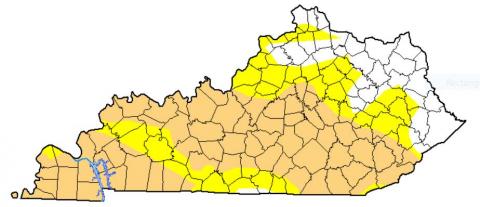Reviving Drought Stressed Pastures
Chris Teutsch, UK Grain and Forage Center of Excellence, Princeton, KY

|
Figure 1. As of July 5, 2022, more than 78% of Kentucky was experiencing abnormally dry (yellow) to moderate drought stress (tan) (The National Drought Mitigation Center, University of Nebraska-Lincoln, Lincoln, NE). |
A very hot and dry early summer combined with overgrazing has significantly reduced pasture growth and vigor in many areas of Kentucky. The good news is that drought stressed pastures often look worse than they really are. This is especially true for pastures that were well managed prior to drought. In many cases pastures can be revived without reseeding. They key element is rainfall. On the flipside, pastures that have been grazed closely and continuously prior to drought often do not fare as well during and after drought. The following are some considerations for reviving drought stressed pastures.
Rest pastures during and after drought. Close the gates! The worst possible thing that we can do during and after a drought is to allow livestock access to all the pastures. During a drought, confining animals to one pasture and feeding hay limits damage to a single pasture and allows the other pastures to adapted to the drought stress. Following a drought, it is important to keep those animals confined to the sacrifice while other pastures recover. This allows pasture plants to rebuild their photosynthetic factory (leaf canopy) and store up sugars and carbohydrates before the winter months. The stockpiled growth that accumulates during this recovery period can then be used for grazing during the winter months after plants have gone dormant.
Fertilize pastures according to soil test. Fertilizing pastures this fall can help to strengthen plants and get them ready to grow next spring. Adjust the soil pH to 6.0 to 6.4, apply phosphorus and potassium according to your soil test, and apply 60-80 lb nitrogen/A in mid-August to mid-September for stockpiling. Alternatively, a smaller amount of nitrogen (30 to 40 lb/A) in November or early December can be applied. This late-season nitrogen application will not produce a great deal of fall growth, but it will stimulate tiller production and root growth. Pasture growth will start earlier in the spring stands will be thicker.

|
Figure 2. Recent research at the USDA Food Animal Production Unit located in Lexington, KY, found that compounds in red clover can reverse vasoconstriction caused by the toxins in endophyte tall fescue. |
Interseed legumes into thin stands. Legumes such as red and white clover, and alfalfa are important components of sustainable grassland ecosystems. They form a symbiotic relationship with rhizobium bacteria in which nitrogen from the air is fixed into a plant available form. They also dilute the toxin in tall fescue infected with the toxic endophyte and in some cases may even reverse the negative effects of the endophyte. Pasture sod suppressed by drought and overgrazing provide a perfect opportunity for interseeding clover and alfalfa. Legumes can be either drilled in the fall or spring or frost seeded in late winter. Frost seeding works best with red and white clover and annual lespedeza. Alfalfa is better established using a no-till drill. For more information on selecting varieties and overseeding contact your local extension agent or visit the UK Forages Webpage at http://forages.ca.uky.edu/.

Figure 3. Winter annuals such as small grains and annual ryegrass can be interseeded into drought stressed pastures that have than stands of perennial cool-season grasses. |
Interseed winter annuals. In some cases, drilling cool-season annuals, such as small gains, annual ryegrass, and brassicas into dormant sods can be cost effective. In this situation, sods are normally in very poor condition and there are simply not enough remaining plants to actively compete with the cool-season annuals. However, interseeding cool-season annuals into a dormant sod that was well managed prior to the drought does not normally work as well as expected. This is due to the fact that the ground is very dry and when the rain finally comes the seed not only starts to germinate and grow, but so does the dormant sod. An established fescue sod has an extensive root system that competes well for limited moisture.
On the other hand, newly established seedlings have a very small root system and are at a serious disadvantage when competing for water and light with an established fescue sod. The best place for cool-season annuals is on cropland that has already been harvested. In general production on these areas will be greater due to the absence competition.
It is important to remember that drought alone rarely kills well managed pasture plants. In most cases pastures can be revived with rain, rest, and a little fertilizer. Weakened sods provide a prime opportunity for incorporating legumes in established pastureland. With a little tender loving care and rainfall this year’s drought stressed pastures will be next year’s green meadows.
More information on reviving drought stressed pastures can be found on the UK Forages webpage or by visiting your local extension office.
